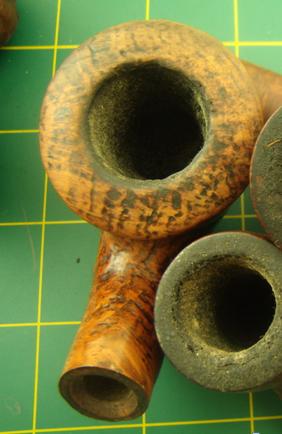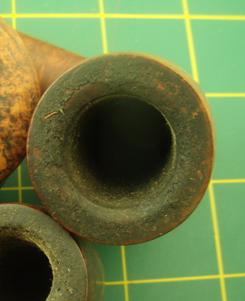The third pipe I worked on in the lot below is the second one down in the third column. It is a Dublin like shape but probably properly is a freehand. It has a shallow sandblast finish with a two-tone stain. The undercoat is black and the top coat is brown. It is stamped on the left side of the shank Racine & Laramie in an arch over OLD TOWN SAN DIEGO over Banza in a script and then a line stamped Made in Italy. The look and feel of it says to me it is made by Lorenzo but I am not sure. When I read the stamping is when the memory came back. I have been in the Racine & Laramie tobacco shop in Old Town San Diego, California. It is a museum like tobacco shop that has a wide range of tobaccos and pipes in an old California mission style village setting. You can almost imagine cowboys riding up and tying up their horse to go in and get a pouch of fixin’s. The picture below is what I remember of the shop. It is from the website http://www.racineandlaramie.com/
The following excerpt on the history of the shop comes from the website as well. I find it incredibly interesting reading.
History of Racine & Laramie
In 1868 Racine & Laramie became San Diego’s first Cigar Store. Having come from eastern Canada in the prosperity following the War Between the States, Messrs. Racine and Laramée sold cigars, tobacco, stationery, pipes, cutlery and gentlemen’s furnishings. The adobe they rented had been built in the 1820’s as the retirement home for leather-jacket soldier, Juan Rodriguez of the Royal Presidio. It was one of the first six buildings in the small pueblo, 500 registered voters, thousands of Kumeyaay. The Rodriguez family held ownership through periods of depression and Gold Rush boom, and their son, Ramon, was on the City Council. The widow Rodriguez had the building remodeled in 1867 and rented to Racine & Laramie and the Bank Exchange saloon. All was lost in the fire of 1872.
Using archeology, historic research and photographs this building has been reconstructed with the interior furnished and stocked as it may have been in that remote, frontier Pacific port. This picture gives a panoramic view of the interior of the shop looking at the cigar humidor.
It was this shop that I visited many times over the years. It is like stepping back in time to enter the old town and then to walk into the shop itself. I think the last time I was there was about six years ago now. I took the train from the downtown harbor area to the old town site. I walked through the reconstructed village. I must have spent 3 or 4 hours wandering around the site and ending up in the old tobacco shop. I looked at pipes and tobaccos before settling on a couple of tins. I think I picked up some Dunhill EMP and maybe a tin of McClelland Dark Star before catching the train back into town.
Needless to say when I found this pipe bowl among the lot pictured below I restemmed it and while working on it relived my visits to the pipe shop in Old Town San Diego.
The finish on the pipe was in pretty good shape – slight wear on the shank area and on the rim left the stain spotty in those areas. The bowl was caked – but differently than most of the pipes I work on. Its cake was primarily in the bottom half of the bowl. The bottom half was thickly caked while the top was not as bad. The photo below shows the bowl as it was when I took it to the work table. The sandblast is either worn from use or it is a lightly blasted finish. The shank was in very good shape and there were no cracks of damage to the inside. The drilling is a bit funny on this as well. It is drilled with a relatively deep mortise and the airway is drilled at the top of the arc of the mortise. It then drops at a sharp angle into the bowl coming out just left of centre in the bottom of the bowl. Because of the high drilling the mortise acts as a sump similar to the Peterson sump in the shank of the system pipes. It was dirty but not with any aromatic residue. Rather the pipe smelled of Virginias and would take little to clean it up.
This pipe that took me several tries to get a stem that would work. This was not due to the look or feel of the stem but due to unforeseen troubles. The first was a nice saddle stem. I turned the tenon and had a great fit on it. I heated it with my heat gun and tried to bend it over my rolling pin to aid in getting the right angles on it. The heat made it very flexible and as I bent it to the correct angle it just snapped in two parts. Those things happen and in this case it was a frustration to be sure – so back to the drawing board. This time I chose a tapered stem. I turned the tenon and fit it to the mortise. I then used the Dremel with the sanding drum to remove the excess material and fit it to the diameter of the shank. I then sanded it with 220 grit sandpaper to finish the fit of the stem. The next three photos show the newly fit stem.
I reamed the pipe with the PipNet reamer and cleaned out cake from the bottom of the bowl. I had to use two different cutting heads on the reamer to get it to remove the cake. The smallest head fit into the bottom half of the bowl and I was able to cut it back until the third head fit and removed cake from the top half and the remaining cake on the bottom half.
I wiped down the bowl and shank with acetone on a cotton pad to remove some of the top coat of stain and even out the lighter areas and the darker areas where the stain was still present. My goal was not to remove all of the stain present but merely even out the top coat so that I could more easily blend in the new stain coat.
Then with a bit of fear and trepidation, after breaking the first stem, I took the stem to the heat gun and heated it so that I could bend it into shape. I inserted a pipe cleaner in the airway as the bend would be quite significant and I did not want to risk having the airway collapse or kink. I heated it a high heat setting until the stem was flexible. I want the bend to be quite high up the stem toward the shank and not just on the thin portion of the stem so it took some time over the heat to make the stem bendable. I kept the stem moving over the heat as I did not want to burn the vulcanite. Once it was pliable I bend it over an old rolling pin that I have absconded with for that purpose. I have a heavy cardboard tube over the pin so that the surface is very smooth for the bend. Any cracks or rough spots on the rolling pin translate into wrinkles in the hot vulcanite.
In the first photo below the bend in the stem can be seen after the first heating. I took it back to my worktable and took the photo below so that I could have a clear look at the bend in comparison with the curves in the bowl. It was not bent enough so I took it back to the heat gun, reheated it and bent it further. The second and third photos below show the final bend that I was aiming for. The bend in the stem reflects the curve of the bottom of the bowl and gives the pipe a pleasant flow. It is also bent perfectly for the pipe to sit well in the mouth.
With the stem bent to the proper angle I worked on its finish with the micromesh sanding pads. I wet sanded the stem with 1500 grit until the major surface flaws were no longer present. The scratches left behind by the sandpaper were gone when I had finished wet sanding it.
I restained the bowl with a dark brown aniline stain thinned to 2 parts stain to 1 part isopropyl alcohol to match the existing stain on the bowl. I applied the stain with a cotton swab, flamed it with a lighter, reapplied more stain and then flamed it again to get the match correct. When finished I took the pipe to the buffer and buffed the pipe and the stem with White Diamond. The next three photos below show the pipe as it stood at this point in the process. The finished shape is very clear in these photos.
I brought it back to the worktable and continued sanding with the micromesh sanding pads. I wet sanded the stem with 1800 and 2400 grit sanding pads. I wiped the stem down between sanding to see how it was progressing. Then I dry sanded with 3200-12,000 grit sanding pads to finish polishing the stem. The next series of four photos show the progressive shine on the stem.
Once the stem was polished I buffed it a second time with White Diamond and then coated the stem with a rub down of Obsidian Oil and let that soak in. After it was dry I rubbed down the stem with a clean cotton rag to bring out the shine even more.
The final four photos show the finished pipe with its new stem. The old Racine & Laramie pipe was back in action and ready to smoke. The back story to this one is as interesting as the old pipe. I wonder the path it took from San Diego to Chicago area and then up to Vancouver, British Columbia. I wonder where it lost its stem along the path it travelled. I only wish it could tell the stories of its travels and the pipemen who smoked it along that journey. I will probably never know the story but at least my imagination can create a suitable tale for the pipe before I too send it on its way, for I am sure it will outlive me as it passes into the hands of future pipemen who come after me.















































































